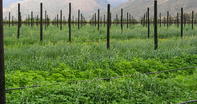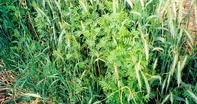Cover crops are planted between vineyards, often in a rotation system from one year to another. This is done for a variety of reasons; mainly for the suppression of weed growth, but also for the reduction of evaporation, the improvement of soil structure and water penetration and to limit soil erosion against slopes.

The optimal planting time for cover crops is at the end of summer when the soil temperature is still high enough for seed germination, but there has already been enough rainfall, normally mid-April to the end of May. The choice of cover crops is mainly determined by the soil type and the wine grape cultivar that has been planted.
A permanent cover crop can be established next to vigorous growing vines, while vines that are slightly stressed will benefit from legumes that add nitrogen to the soil. Other cover crops will help to remove excessive moisture from the soil. The most popular cover crop is triticale (a hybrid of wheat and rye), but many producers prefer to plant seed mixtures.

Cover crops that are chemically or mechanically controlled can form a very dense organic mass on the soil surface which reduces soil temperature and controls water losses from the surface. This organic mass can move into the soil in order to help improve the soil structure and water-holding capacity.
Sometimes cover crops serve as green manure when young plants are incorporated into the soil. Cover crops are selected to perform certain functions. Legumes (like lupins, clover, vetches and serradella) bind nitrogen into the atmosphere and release it into the soil to increase the soil’s nitrogen content. Some cover crops are chosen for their suitability as housing for bio-predators.
It attracts insects which are the natural enemies of vines. Examples of suitable cover crops are radish and white mustard. White mustard and saia oats are also useful as allelopathic plants to suppress the growth of weeds.
Fava beans are ideal for wet, acidic soils and help with nitrogen fertilization. Other cover crops such as grains and paspalum serve as groundcovers against erosion. To eliminate the competition for nutrients with the vines, the cover crops are rolled flat or killed by September just as budburst begin.
By Marinda Louw